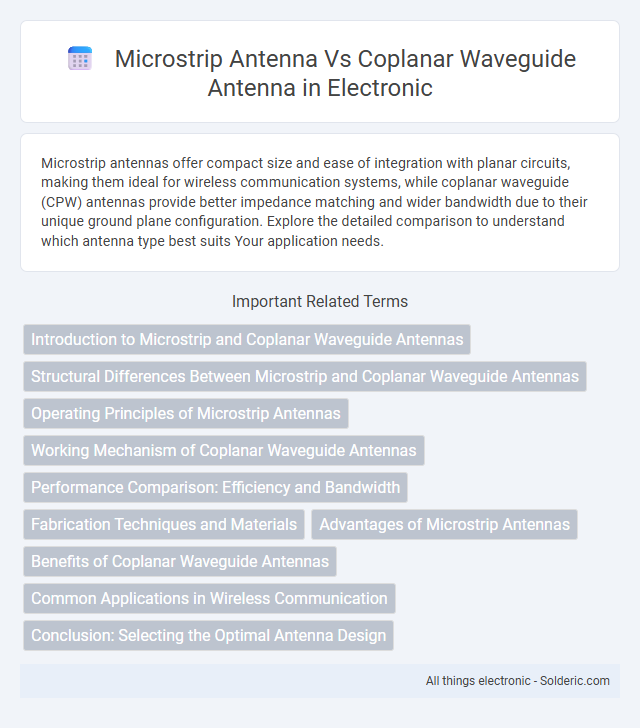Microstrip antennas offer compact size and ease of integration with planar circuits, making them ideal for wireless communication systems, while coplanar waveguide (CPW) antennas provide better impedance matching and wider bandwidth due to their unique ground plane configuration. Explore the detailed comparison to understand which antenna type best suits Your application needs.
Comparison Table
| Feature | Microstrip Antenna | Coplanar Waveguide Antenna |
|---|---|---|
| Structure | Conductive patch on dielectric substrate over ground plane | Signal conductor with two ground conductors on same plane |
| Impedance Matching | Requires inset feed or coaxial feed | Intrinsic, easier with coplanar geometry |
| Bandwidth | Narrow to moderate (few percent) | Typically wider than microstrip antennas |
| Radiation Efficiency | Moderate, affected by substrate losses | Higher efficiency due to planar design |
| Fabrication Complexity | Simple, well-established | More complex, requires precise gap control |
| Application | Mobile devices, GPS, WLAN | High-frequency circuits, broadband systems |
Introduction to Microstrip and Coplanar Waveguide Antennas
Microstrip antennas consist of a radiating patch on one side of a dielectric substrate with a ground plane on the other, offering low-profile, lightweight designs ideal for compact wireless devices. Coplanar waveguide (CPW) antennas feature conductors and ground planes on the same substrate surface, providing easier integration with active circuits and reduced radiation loss. Understanding these key structural differences helps optimize Your antenna choice based on application-specific requirements like bandwidth, efficiency, and fabrication complexity.
Structural Differences Between Microstrip and Coplanar Waveguide Antennas
Microstrip antennas feature a radiating patch on one side of a dielectric substrate with a full ground plane on the opposite side, whereas coplanar waveguide (CPW) antennas have the signal conductor and ground conductors on the same substrate surface, separated by narrow gaps. This structural difference results in microstrip antennas typically requiring a solid ground plane, while CPW antennas enable easier integration with planar circuits and improved impedance matching due to the coplanar configuration. Your choice between these antennas depends on factors like fabrication complexity, substrate thickness, and desired radiation characteristics influenced by these structural variations.
Operating Principles of Microstrip Antennas
Microstrip antennas operate by radiating electromagnetic waves through a radiating patch on a grounded substrate, where the patch functions as a resonant element. The antenna's performance depends on the patch shape, size, substrate thickness, and dielectric constant, affecting parameters like bandwidth and radiation pattern. Your choice between microstrip and coplanar waveguide antennas should consider these factors for optimal integration in wireless communication systems.
Working Mechanism of Coplanar Waveguide Antennas
Coplanar waveguide (CPW) antennas operate by guiding electromagnetic waves through a single conductor flanked by two ground planes on the same substrate surface, which enables easy integration with planar circuits. The signal propagation in CPW is characterized by quasi-TEM mode, offering low dispersion and improved impedance matching. This design facilitates compact antenna structures with wide bandwidth and reduced radiation loss compared to microstrip antennas, which use a distinct ground plane separated by a dielectric layer.
Performance Comparison: Efficiency and Bandwidth
Microstrip antennas typically offer moderate efficiency with limited bandwidth due to dielectric and conductor losses, making them suitable for compact, low-profile applications. Coplanar waveguide antennas achieve higher efficiency and broader bandwidth by minimizing substrate modes and radiation losses through their unique planar transmission line structure. Efficiency of coplanar waveguide antennas often exceeds 80%, while microstrip antennas generally range between 50-70%, with coplanar designs supporting bandwidths up to several GHz compared to microstrip's narrower bandwidth range.
Fabrication Techniques and Materials
Microstrip antennas typically utilize printed circuit board (PCB) fabrication techniques involving etching copper-clad substrates such as FR4, Rogers, or Duroid materials, offering low-cost and easily reproducible manufacturing. Coplanar waveguide (CPW) antennas are fabricated using photolithography and etching on similar substrates but require precise control of the ground plane and signal line dimensions to achieve desired characteristic impedance and minimize loss. Advanced CPW antenna fabrication may incorporate high-frequency laminates like Taconic or quartz to enhance performance in millimeter-wave applications, highlighting material selection's critical role in antenna efficiency and bandwidth.
Advantages of Microstrip Antennas
Microstrip antennas offer advantages such as low profile, lightweight design, ease of fabrication, and compatibility with planar and non-planar surfaces, making them ideal for compact wireless devices. Their ability to integrate seamlessly with printed circuit boards supports efficient mass production and cost-effectiveness. You benefit from the antenna's versatility in frequency tuning and polarization diversity, enhancing overall system performance.
Benefits of Coplanar Waveguide Antennas
Coplanar waveguide antennas offer superior integration with monolithic microwave integrated circuits (MMICs) due to their planar structure and ease of fabrication. They provide better impedance matching and reduced radiation loss compared to microstrip antennas, resulting in enhanced signal integrity and efficiency. These antennas also exhibit excellent broadband performance and low dispersion, making them ideal for high-frequency applications.
Common Applications in Wireless Communication
Microstrip antennas are widely used in satellite communication, mobile devices, and RFID systems due to their low profile and ease of integration with printed circuit boards. Coplanar waveguide antennas find common applications in millimeter-wave communication, 5G networks, and radar systems because of their superior impedance matching and reduced radiation loss. Both antenna types cater to high-frequency wireless communication but are selected based on specific performance requirements and fabrication constraints.
Conclusion: Selecting the Optimal Antenna Design
Microstrip antennas offer compact size and ease of fabrication, making them ideal for integrated circuits and portable devices, while coplanar waveguide antennas provide enhanced bandwidth and reduced surface wave losses suitable for high-frequency applications. Your choice depends on specific requirements such as operating frequency, bandwidth, and integration complexity. Balancing these factors ensures optimal antenna performance tailored to your communication system needs.
microstrip antenna vs coplanar waveguide antenna Infographic

 solderic.com
solderic.com